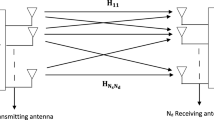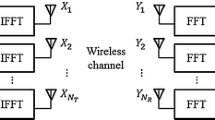Abstract
In this work, some aspects of the sorted QR decomposition are addressed for ordered successive–interference–cancellation detection in large-scale antenna systems. An analysis on the sorted QR decomposition behavior, including its impact on the performance of symbol detection in large ill conditioned MIMO channel matrices, has been presented. As the correlation on the channel matrix grows, the sorted QR decomposition may not ensure its requirements, causing misleading symbol estimation. In this context, it is shown that orthogonality condition may be broken, depending on the matrix condition, which comes from propagation errors on the norm updating of the modified Gram–Schimidt method. Numerical results have corroborated our claims, demonstrating the sensitivity of the Gram–Schimidt algorithm, as well as the deterioration of the large-scale MIMO detection performance under highly correlated channels scenarios.






Similar content being viewed by others
Notes
MTs are usually apart from it other, not sharing information between them.
One symbol per transmission antenna.
In this work, the transmitted power has been normalized by the total number of antennas \(KN_K\).
Precoding and beamforming are more suitable in this case.
This approximates the estimated symbol to the closest point in modulation constellation set.
line 2 of Algorithm 1.
The modified GS method takes N steps, i.e., \(\ell =\left\{ {1,2,\ldots , N}\right\} \).
References
Awasthi, A., Guttal, R., Al-dhahir, N., & Balsara, P. T. (2014). Complex QR decomposition using fast plane rotations for MIMO applications. IEEE Communications Letters, 18(10), 1743–1746.
Boccardi, F., Marzetta, T. L., & Labs, B. (2014). Five disruptive technology directions for 5G. IEEE Communications Magazine, 52(February), 74–80.
Böhnke, R., Wübben, D., Kühn, V., & Kammeyer, K. D. (2003). Reduced complexity MMSE detection for BLAST architectures. GLOBECOM ’03. EEE Global Telecommunications Conference, 4(1), 2258–2262. doi:10.1109/GLOCOM.2003.1258637.
Chiu, C. Y., Yan, J. B., & Murch, R. D. (2008). 24-Port and 36-port antenna cubes suitable for MIMO wireless communications. IEEE Transactions on Antennas and Propagation, 56(4), 1170–1176. doi:10.1109/TAP.2008.919202.
Cox, A. J., & Higham, N. J. (1998). Stability of householder QR factorization for weighted least squares problems. In Numerical Analysis 1997, Proceedings of the 17th Dundee Conference, Pitman Research Notes Mathematics 380, 57.
Gander, W. (1980). Algorithms for the QR-decomposition. Technical Reports.
Jalden, J., & Ottersten, B. (2005). On the complexity of sphere decoding in digital communications. IEEE Transactions on Signal Processing, 53(4), 1474–1484. doi:10.1109/TSP.2005.843746.
Jalden, J., Seethaler, D., & Matz, G. (2008). Worst- and average-case complexity of lll lattice reduction in mimo wireless systems. In Acoustics, speech and signal processing, 2008. IEEE International Conference on ICASSP 2008, (pp. 2685–2688). doi:10.1109/ICASSP.2008.4518202.
Kim, T. H. (2014). Low-complexity sorted QR decomposition for MIMO systems based on pairwise column symmetrization. IEEE Transactions on Wireless Communications, 13(3), 1388–1396. doi:10.1109/TWC.2014.011514.130566.
Kobayashi, R., Ciriaco, F., & Abrao, T. (2015). Efficient near-optimum detectors for large mimo systems under correlated channels. Wireless Personal Communications, 83(2), 1287–1311. doi:10.1007/s11277-015-2450-y.
Lai, R. H. L. R. H., Chen, C. M. C. C. M., Ting, P. A. T. P. A., & Huang, Y. H. H. Y. H. (2009). A modified sorted-QR decomposition algorithm for parallel processing in MIMO detection. In 2009 IEEE International Symposium on Circuits and Systems, (pp. 1405–1408). doi:10.1109/ISCAS.2009.5118028.
Larsson, Y. E. G., & Labs, B. (2014). Massive MIMO for next generation wireless systems. IEEE Communications Magazine, 52(2), 186–195. doi:10.1109/MCOM.2014.6736761.
Ma, X., & Zhang, W. (2008). Performance analysis for MIMO systems with lattice-reduction aided linear equalization. IEEE Transactions on Communications, 56(2), 309–318. doi:10.1109/TCOMM.2008.060372.
Mondal, S., Salama, K. N., & Ali, W. H. (2008). A novel approach for K-best MIMO detection and its VLSI implementation. In Proceedings–IEEE International Symposium on Circuits and Systems, (pp. 936–939). doi:10.1109/ISCAS.2008.4541573.
Patel, D., Smolyakov, V., Shabany, M., & Gulak, P. (2010). Vlsi implementation of a wimax/lte compliant low-complexity high-throughput soft-output k-best mimo detector. In Proceedings of 2010 IEEE International Symposium on Circuits and Systems (ISCAS), (pp. 593–596). doi:10.1109/ISCAS.2010.5537524.
Peng, X., Wu, W., Sun, J., & Liu, Y. (2015). Sparsity-boosted detection for large mimo systems. IEEE Communications Letters, 19(2), 191–194. doi:10.1109/LCOMM.2014.2377215.
Persson, D., Lau, B. K., & Larsson, E. G. (2012). Scaling Up MIMO. IEEE Signal Processing Magazine (2013), (pp. 40–60).
Roh, W., Seol, J. Y., Park, J., Lee, B., Lee, J., Kim, Y., et al. (2014). Millimeter-wave beamforming as an enabling technology for 5G cellular communications: Theoretical feasibility and prototype results. IEEE Communications Magazine, 52(2), 106–113. doi:10.1109/MCOM.2014.6736750.
Rusek, F., Persson, D., Lau, B. K., Larsson, E., Marzetta, T., Edfors, O., et al. (2013). Scaling up mimo: Opportunities and challenges with very large arrays. IEEE Signal Processing Magazine, 30(1), 40–60. doi:10.1109/MSP.2011.2178495.
Shen, C. A., Eltawil, A., Salama, K., & Mondal, S. (2012). A best-first soft hard decision tree searching mimo decoder for a 4x4 64-qam system. IEEE Transactions on Very Large Scale Integration (VLSI) Systems, 20(8), 1537–1541. doi:10.1109/TVLSI.2011.2159821.
Shepard, C., Yu, H., Anand, N., Li, E., Marzetta, T., Yang, R., & Zhong, L. (2012). Argos: Practical many-antenna base stations. In Proceedings of the 18th Annual International Conference on Mobile Computing and Networking—Mobicom ’12 (i), 53. doi:10.1145/2348543.2348553.
Srinidhi, N., Datta, T., Chockalingam, A., & Rajan, B. (2010). Layered tabu search algorithm for large-mimo detection and a lower bound on ml performance. In 2010 IEEE Global Telecommunications Conference (GLOBECOM 2010), (pp. 1–5). doi:10.1109/GLOCOM.2010.5683251.
Valente, R. A., Marinello, J. C., & Abrao, T. (2014). LR-aided MIMO detectors under correlated and imperfectly estimated channels. Wireless Personal Communications, 77(1), 173–196. doi:10.1007/s11277-013-1500-6.
Waters, D., & Barry, J. (2005). The sorted-QR Chase detector for multiple-input multiple-output channels. In Wireless Communications and Networking Conference, 2005 IEEE, vol. 1 (pp. 538–543). doi:10.1109/WCNC.2005.1424558.
Wolniansky, P., Foschini, G., Golden, G., & Valenzuela, R. (1998). V-BLAST: An architecture for realizing very high data rates over the rich-scattering wireless channel. In Conference Proceedings 1998 URSI International Symposium on Signals, Systems, and Electronics (pp. 295–300). doi:10.1109/ISSSE.1998.738086.
Wübben, D., Böhnke, R., Kühn, V., Kammeyer, K. D. (2003). MMSE extension of V-BLAST based on sorted QR decomposition. VTC 2003-Fall 2003 IEEE 58th Vehicular Technology Conference 1(1), 0–4. doi:10.1109/VETECF.2003.1285069.
Wübben, D., Böhnke, R., Rinas, J., Kühn, V., & Kammeyer, K. (2001). Efficient algorithm for decoding layered space-time codes. Electronics Letters, 37(22), 1348. doi:10.1049/el:20010899.
Xu, W., Wang, Y., Li, A., Zhou, Z., & Wang, J. (2004). A fast recursive sphere decoder with linear storage. In The 2004 Joint Conference of the 10th Asia-Pacific Conference on Communications, 2004 and the 5th International Symposium on Multi-Dimensional Mobile Communications Proceedings, vol. 1, (pp. 34–38). doi:10.1109/APCC.2004.1391646.
Yang, H., & Marzetta, T. L. (2013). Performance of conjugate and zero-forcing beamforming in large-scale antenna systems. IEEE Journal on Selected Areas in Communications, 31(2), 172–179. doi:10.1109/JSAC.2013.130206.
Yang, S., & Hanzo, L. (2015). Fifty years of MIMO detection: The road to large-scale mimos. CoRR arXiv:1507.05138.
Zelst, A. V., & Hammerschmidt, J. (2002). A single coefficient spatial correlation model for multiple-input multiple-output (MIMO) radio channels. In 27th General Assembly of the International Union of Radio Science (URSI) (1), 2–5.
Zimmermann, E., Rave, W., & Fettweis, G. (2004). On the complexity of sphere decoding. IEEE Transactions on Signal Processing, 53(4), 1474–1484.
Acknowledgments
This work was supported in part by the Araucaria Foundation, PR, Brazil under Grant 302/2012, and National Council for Scientific and Technological Development (CNPq) of Brazil under Grant 304358/2012-6
Author information
Authors and Affiliations
Corresponding author
Rights and permissions
About this article
Cite this article
Kobayashi, R.T., Abrão, T. Ordered MMSE–SIC via sorted QR decomposition in ill conditioned large-scale MIMO channels. Telecommun Syst 63, 335–346 (2016). https://doi.org/10.1007/s11235-015-0123-5
Published:
Issue Date:
DOI: https://doi.org/10.1007/s11235-015-0123-5




